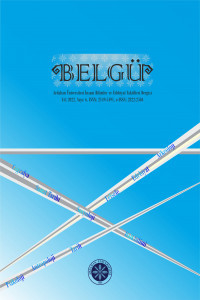Şanlıurfa Bölgesi Neolitik Dönem Araştırmaları
Bu çalışmada, Türkiye’nin güneydoğusunda bulunan Urfa bölgesinin merkez ilçesindeki yüzey araştırmasında keşfedilen Neolitik dönem yerleşimlerinden bahsedilmektedir. Yeni yerleşimlerin birinde tespit edilen “T” şeklinde dikmetaşların boyutlarından yola çıkılarak, Göbekli Tepe’nin II. tabakası ve Nevali Çori’den bilinen kült yapısı ile çağdaş olduğu düşünülmektedir. Yerleşimlerin bazılarında görülen yuvarlak planlı yapı kalıntıları, bu yerleşimlerin Çayönü, Hallan Çemi, Gusir Höyük, Körtik Tepe ve Hasankeyf Höyük’te tespit edilen yuvarlak planlı yapılarla benzer özellikleri olduğunu göstermektedir. Tespit edilen bazı yerleşimlerin ise daha çok mevsimlik konaklama için kullanılmış yerleşimler olduğu tahmin edilmektedir. Urfa bölgesinde ilk kez keşfedilen bu yerleşimlerin tümünü, küçük buluntular ışığında Çanak Çömleksiz Neolitik Dönem A evresinin sonu (LPPNA) ile B evresinin sonları (LPPNB) arasına tarihlendirmek mümkündür
The Neolithic Period Survey in Sanliurfa Region
In this study it’s mentioned about the Neolithic period settlements discovered during the survey conducted at the central district of Urfa region, southeast of Turkey. Based on the dimensions of the T-shaped pillars discovered at several of such recently discovered settlements, it is thought that the settlement is contemporaneous with Layer II of Göbekli Tepe and the cult structure familiar with from Nevali Çori. Round planned structure remains revealed in some of the settlements suggest that such settlements present similar characteristics with the round planned structures discovered at Çayönü, Hallan Çemi, Gusir Höyük, Körtik Tepe and Hasankeyf Höyük. It is estimated that some of the discovered settlements are rather used for seasonal accommodation. It is possible to date all such settlements discovered for the first time at Urfa region to a period between late Pre-Pottery Neolithic Period A (LPPNA) and late period B (LPPNB) in the light of the small finds
